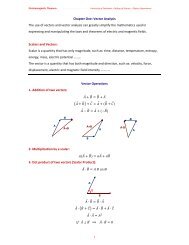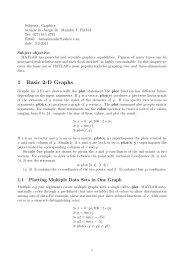Using Cumulative Count Of Conforming CCC-Chart to Study the ...
Using Cumulative Count Of Conforming CCC-Chart to Study the ...
Using Cumulative Count Of Conforming CCC-Chart to Study the ...
Create successful ePaper yourself
Turn your PDF publications into a flip-book with our unique Google optimized e-Paper software.
8<br />
6-2 Quesenberry’s Q-Transformation<br />
<strong>Using</strong> Q -1 <strong>to</strong> denote <strong>the</strong> inverse function of standard normal distribution, define<br />
Q<br />
i<br />
= −Q<br />
where<br />
−1<br />
( u )<br />
i<br />
xi ui<br />
= F(<br />
xi<br />
, p)<br />
= 1−<br />
(1 − p)<br />
For i = 1,2,3 ,.... Qi<br />
Will approximately follow <strong>the</strong> standard normal distribution, and <strong>the</strong> accuracy<br />
improves as p approaches zero.<br />
Table (6-4) shows <strong>the</strong> data of Quesenberry’s Transformation of <strong>CCC</strong>-EXP data<br />
Q i Q i Q i Q i<br />
0.2327 2.326 0.7507 0.7621<br />
-0.2611 2.326 2.326 0.9385<br />
2.326 0.1257 2.326 -0.2224<br />
2.326 1.0494 2.326 1.0494<br />
0.628 2.326 2.326 0.7507<br />
2.326 0.7507 -1.165 2.326<br />
2.326 2.326 -1.2873 1.0494<br />
0.4316 -1.165 1.4532 1.0494<br />
0.628 -0.3836 0.0426 2.326<br />
-0.831 2.326 0.9002 2.326<br />
0.7507<br />
5.8<br />
X <strong>Chart</strong> for Quesenberry<br />
3.8<br />
UCL = 4.31<br />
X<br />
1.8<br />
-0.2<br />
CTR = 1.10<br />
-2.2<br />
LCL = -2.10<br />
0 10 20 30 40 50<br />
Observation<br />
Fig(6-4) The individual chart of <strong>CCC</strong>_EXP data with Q- Transformation<br />
From above chart of Q- Transformation, it shows that all points are within <strong>the</strong><br />
control limits and <strong>the</strong> process is in control.
















